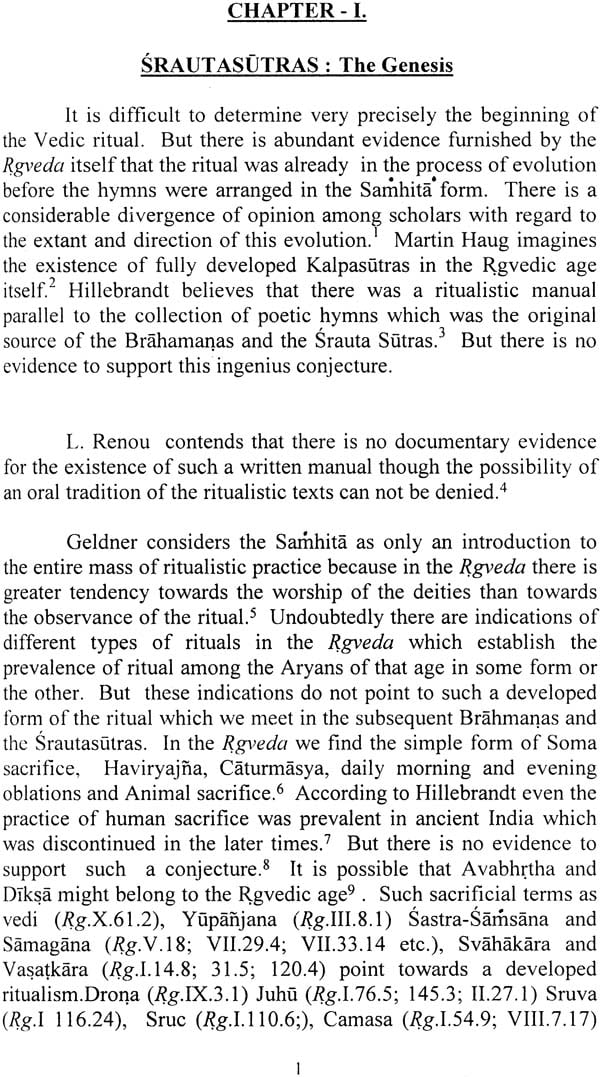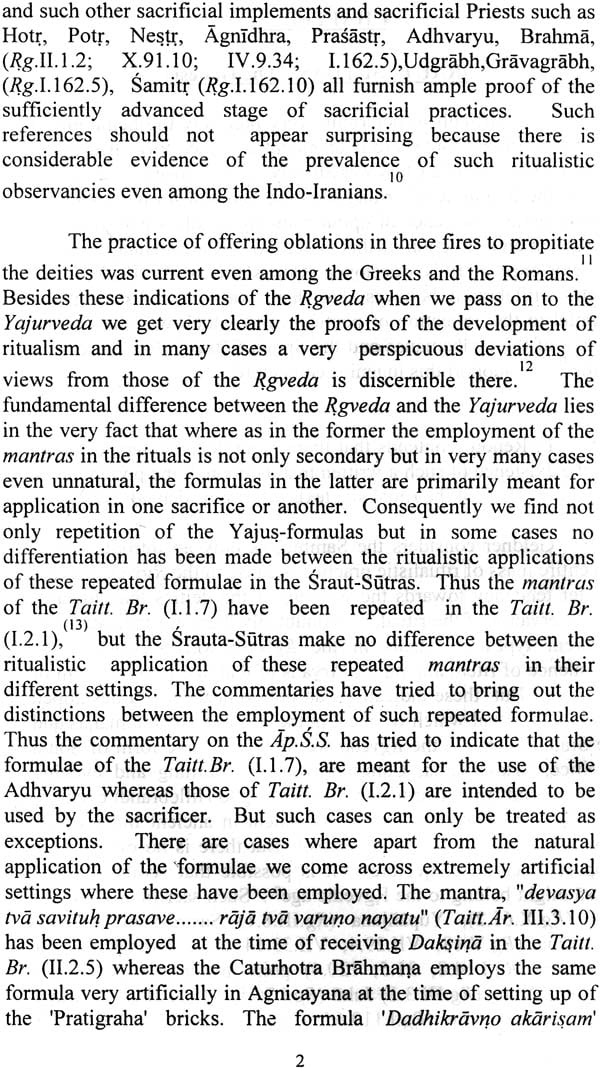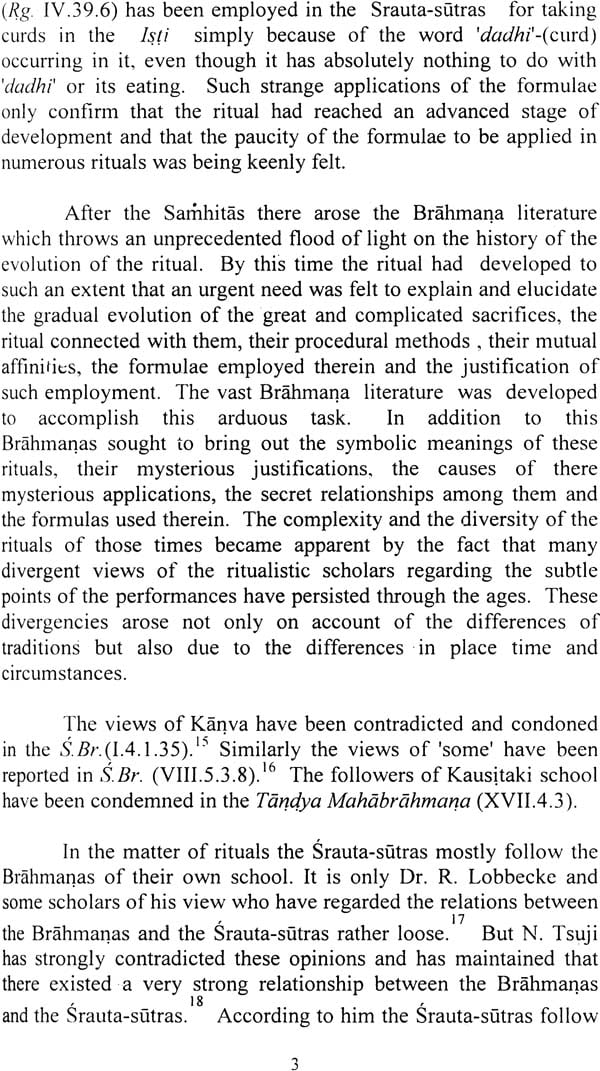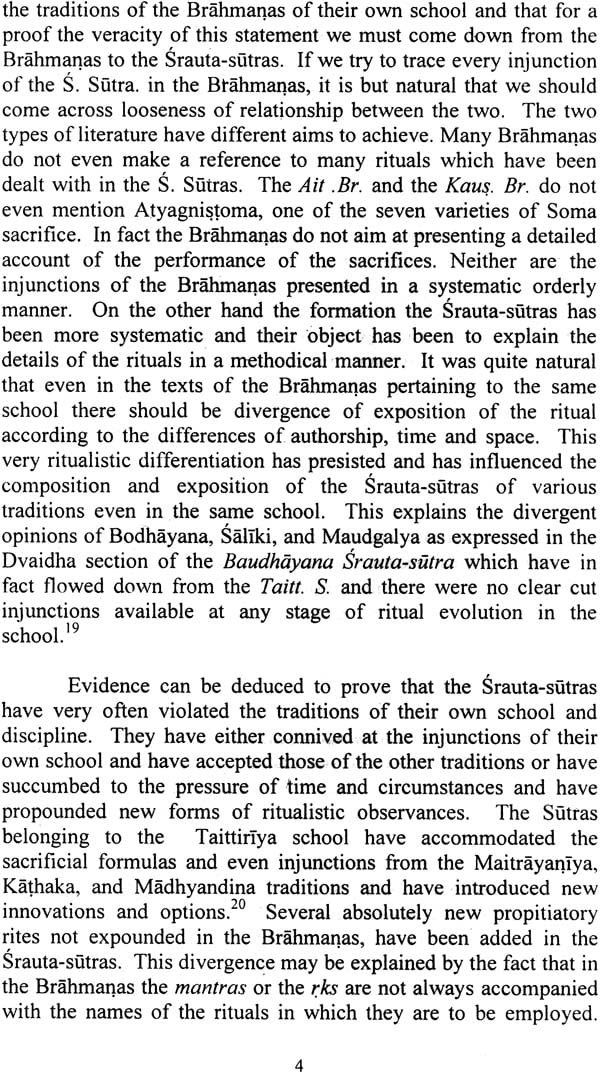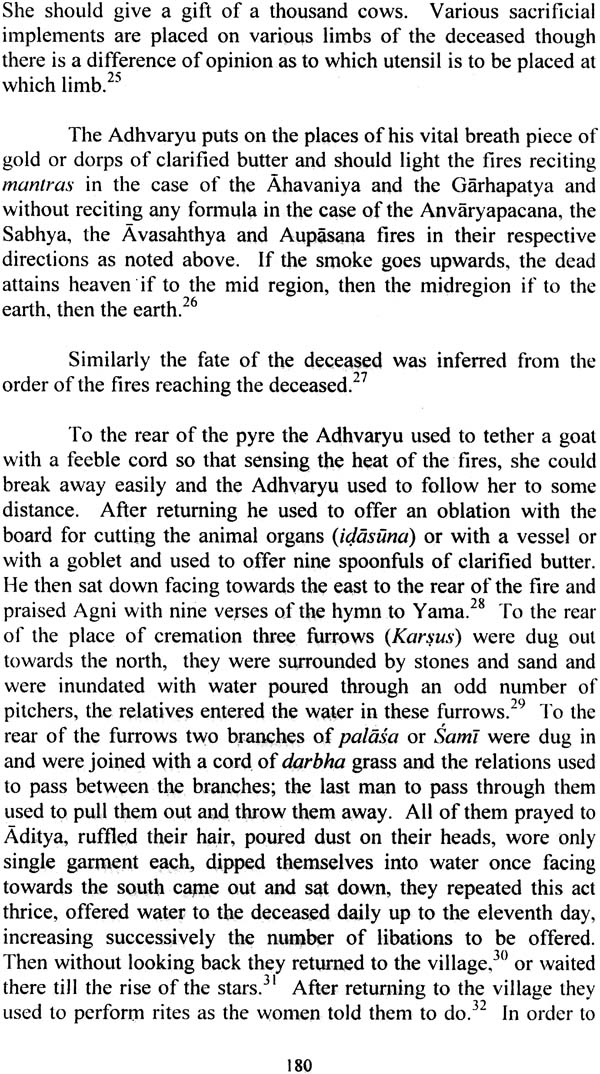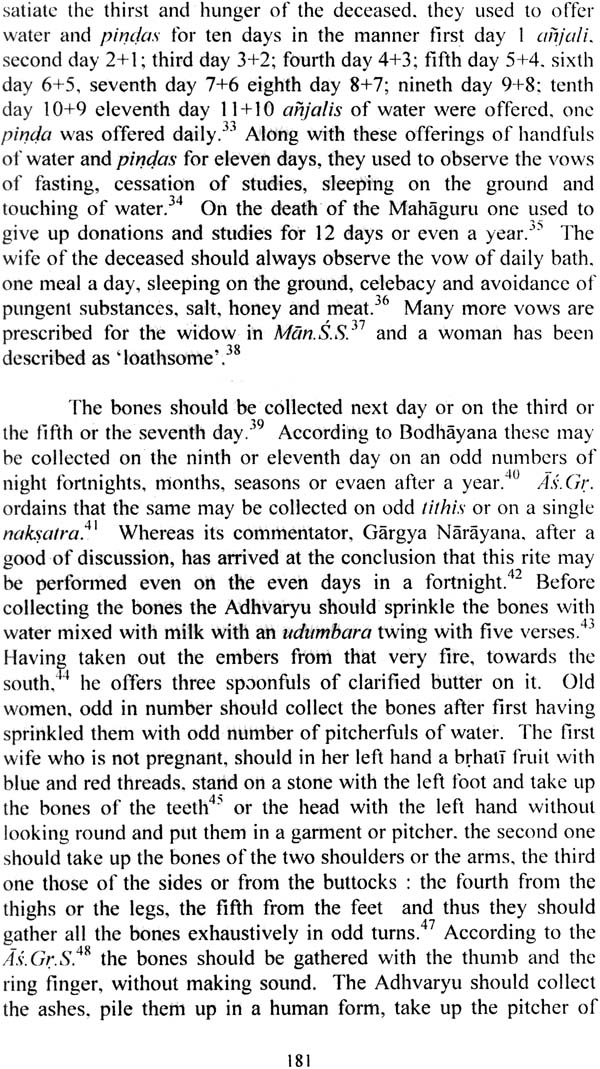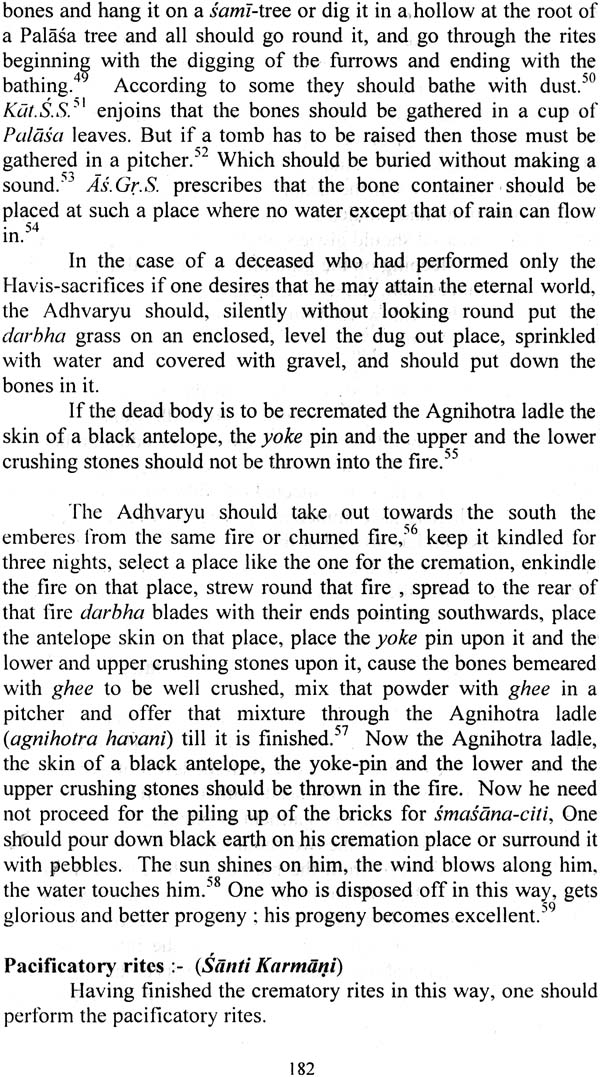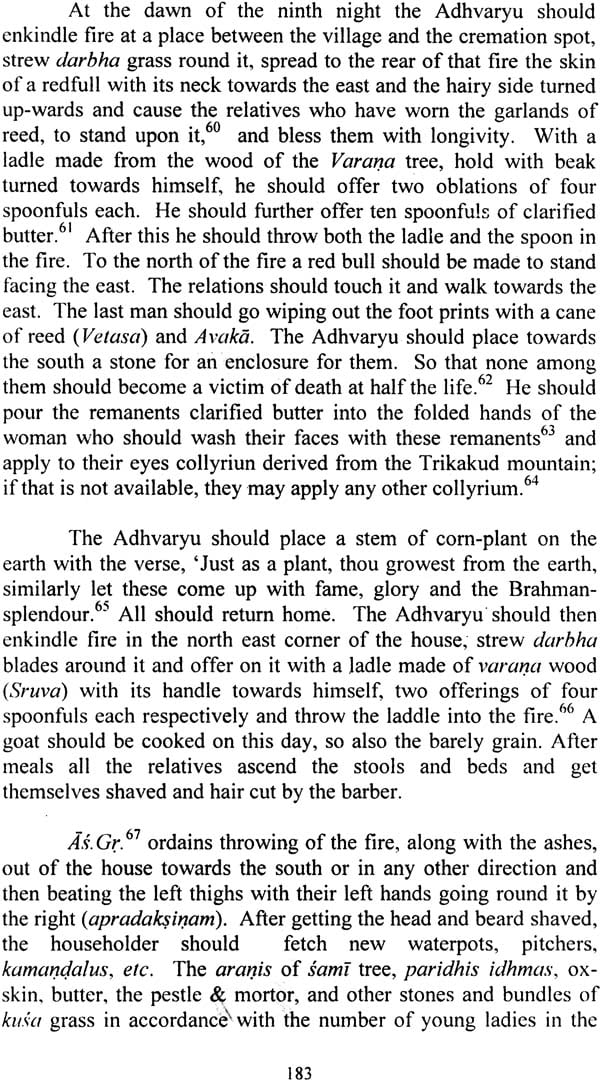
Srautasutras
Book Specification
| Item Code: | NAC010 |
| Author: | Kundan Lal Sharma |
| Publisher: | Vishveshvaranand Book Agency, Hoshiarpur |
| Edition: | 2004 |
| Pages: | 215 |
| Cover: | Hardcover |
| Other Details | 10.0 Inch X 6.5 Inch |
| Weight | 400 gm |
Book Description
Kalpa Sutras have an important and considerable place in the Vedic Literature. According to Acharya Vishva Bandhu Ji:
"The primary Vedic literature consisting of the Samhitas, the Brahmanas, the Aranyakas and the Upanishads presupposes the pre- valence among and around the people that produced it of fairly developed conceptions and well established traditions of the practice of morals, religious sacrifices and formal ceremonies, suffusing its life at all levels individual, domestic, social and political. Held as prescribed by tradition, documentary or oral, these practices bore the generic names of Dharman and Karman both of which were synonymous. Another synonym of these was the term Kalpa which designated, in common, the vast body of auxiliary writings composed towards systematic preservation, presentation and prescription of the said moral rules, customary practices and sacrificial and ceremonial rites. Of these compendia, the Dharma-sutras codified the personal, the domestic and the socio-political rules of conduct (acara-vyavahara) which had either been expressly taught by the sacred texts or were indicated by the manners and customs which had come down form generation to generation. From and around these rules has developed, in course of time, the vast literature comprising, the Dharma-sastras, the Smrtis and the Nibandhas being the original authorities behind the indigenous jurisprudence and administration, in consonance with it, of law and justice in India.
The extensive Vedic (Srauta) sacrifices (yajnah) like the lunar Darsa-paurnamasa, the seasonal Caturmasya, the general Agni- stoma and others which required oblations being made of clarified butter (ajya) and soma-juice along with plant and animal offerings to the Fire-God in His own right and as a medium of approach to the other Gods were treated of in the Srauta—si1tras. The actual performance of these rites was preceded by the construction in the open of platform- like altars (vedis) of varied designs (citis), built of unbaked bricks. Separate places were provided therein for kindling the three sacrificial tires (tretagni), the main one called the Ahavaniya being placed in the east with the other two, namely, the Garhapatya in the west and the Daksina in the south. At the outset, the sacrificer (yajamana) would nominate (varana) the priests (rtvijs) including the four principal ones, namely, the Hotr, the Udgatr, the Adhvaryu and the Brahman along with their about a dozen strong team of severally designated assistant priests who, then, would proceed. Ceremoniously, to churn (manth) the sacrificial fire out of the two logs (arani) of attritable wood and to deposit (a-dha) it place-wise. Some of the Srauta-sutras also had the Mensuration Section (Sulba-Sutra) as an appendix at the end, specifying the necessary measurements and describing the method of constructing the various types and portions of the altar (vedi).
These supplements may thus be said to represent the earliest Indian contribution to the Science of Geometry. The remaining constituent of the Kalpa, namely, the Grhya-si1tras dealt with the comparatively simpler rites and ceremonies like the five daily sacrifices (mahayajnas) and the sixteen sacraments (samskaras) performed on such occasions as conception (garbhadhana), birth (jatakarman), tonsure (mundana), investiture with the sacred thread (yanopavita), educational initiation (vedarambha), graduation (diksanta), marriage (vivaha) and obsequies (antyesti). The domestic sacred five (grhyagni) and the family priest (purohita) only were required for the performance of these rites and ceremonies. In general, these three-fold Kalpa—sutras supply copious details regarding the social and economic organisation, the everyday life, the system of government, the administration of law and justice, the marriage laws, customs, rites and festivities, the maternity and child-welfare sacraments, the system of education, the daily, periodical and special sacrifices, the funeral rites and the offerings to the forefathers. The Kalpa works which are available at this time represent among themselves about two dozen Vedic Recensions (sakhas). A mention may be made of Apastamba, Kasyapa, Gautama, Visnu, Vasistha, Vaikhanasa, Sumantu and Hiranyakesin among the Dharma-sutras, of Apastamba, Asvalayana, Kathaka, Katyayana, Jaminiya, Drahyayana, Baudhayana, Manava, Latyayana, Vadhula, Varaha, Vaikhanasa, Vaitana and Hiranyakesin among the Srauta-sutras and of Agnivesya, Apastamba, Asvalayana Kathaka, Kausitaki, Kausika, Gobhila, Jaminiya, Drahyayana, Baijavapa, Baudhayana, Bharadvaja, Manava, Varaha, Vaikhanasa and Hiranyakesin among the Grhya—sutras," (The Vedas and Sastras, p. l2 to 14).
Prof. Kundan Lal Sharma was of the opinion that the available material of Vedic History was not sufficient and up to the mark. There were so many shortcomings in that material, so it could not have done justice to the students of Vedic Literature. Then he made up his mind to get the Vedic History revised. He planned to prepare seven volumes of the Vedic History. It was a large project and the work was very laborious and tedious. He worked very hard and could prepare only four volumes in his life-time. As ill luck would have it, Prof. Sharma died on 20th November, 1983 at Delhi. He was a heart-patient.
The three Volumes ‘Kalpa Sutras’, Vedangas’ and ‘Yajurveda and Samaveda Samhitayen’ were published in 1981, 1983 and 1985 simultaneously. These Volumes were in Hindi and were printed by the V.V.R. Institute, Hoshiarpur. The present Volume ‘Kalpa Sutras’ in English is now being printed through the V.V.R. Institute, Hoshiarpur. This Volume is being printed very late, but ‘all is well that ends well’. This Volume could see the light of the day only due to the hard efforts of the pious and devoted lady, Smt. Pushpa Sharma. She left no Institutions for the purpose, but at last only the V.V.R.I came forward to print it. The present Volume includes ‘Srauta Sutras’ ‘Sulba Sutras’ and ‘Pitrmedha Sutras’ only. The Writer did his best to illustrate the Vedic terms in this Volume. He supported the fats with the authentic references available. This Volume will be very helpful to the Vedi c Scholars in very respect. They will always be indebted to revered wife of Prof. Kundan Lal Sharma.
| Preface | iii-v | |
| Chapter-I | Srautasutras: The Genesis | 1-13 |
| Chapter-II | Asvalayana Srauta Sutra | 14-30 |
| Chapter-III | Manava Srauta Sutra | 31-59 |
| Chapter-IV | Apastamba Srauta Sutra | 60-79 |
| Chapter-V | Varaha Srauta Sutra | 80-89 |
| Chapter-VI | Katyayana Srauta Sutra | 90-97 |
| Chapter-VII | Jaiminiya Srauta Sutra | 98-113 |
| Chapter-VIII | Latyayana Srauta Sutra | 114-130 |
| Chapter-IX | Vaitana Srauta Sutra | 131-139 |
| Chapter-X | Sulba Sutras | 140-152 |
| Chapter-XI | Baudhayana Sulba Sutra | 153-157 |
| Manava Sulba Sutra | 158-161 | |
| Apastamba Sulba Sutra | 161-169 | |
| Hiranyakesiya or Satyasadha Sulba Sutra | 169-169 | |
| Maitrayaniya Sulba Sutra | 169 | |
| Varaha Sulba Sutra | 169-170 | |
| Chapter-XII | Katyayana Sulba Sutra | 173-175 |
| Chapter-XIII | Pitrmedha Sutras | 176-191 |
| Chapter-XIV | Baudhayana Pitrmedha Sutra | 192-196 |
| Apastamba Pitrmedha Sutra | 196-197 | |
| Manava Pitrmedha Sutra | 197-198 | |
| Agnivesya Pitrmedha Sutra | 198 | |
| Katyayana Pitrmedha Sutra | 198-200 | |
| Satyasadha Hiranyakesi Pitrmedha Sutra | 200-201 | |
| Gautama Pitrmedha Sutra | 201-201 | |
| Kausitaka Pitrmedha Sutra | 201 | |
| Sankhayana Pitrmedha Sutra | 201-202 | |
| Asvalayana Pitrmedha Sutra | 202 | |
| Kathaka Pitrmedha Sutra | 202 | |
| Agnivesya Pitrmedha Sutra | 202 | |
| Vaikhanasa Pitrmedha Sutra | 202-204 | |
| Kausika Pitrmedha Sutra | 204-207 |
